Music is the universal language
“Glory to God in the highest heaven, and on earth peace to those on whom his favor rests.” - Luke 2:14
Norse Guitar Feeds
Christone “Kingfish” Ingram picks his six most influential blues guitar albums of all time

Christone “Kingfish” Ingram burst onto the blues scene a decade ago as a teenage electric prodigy. Now the erstwhile son of Clarksdale, Mississippi is back with Hard Road – a new album of modern blues released on his new label Red Zero Records and an upcoming world tour to support it.
Anyone who has had the pleasure of hearing Ingram’s calling down the thunder with his soulful vocals interspersed with searing lead lines – from his signature Fender Telecaster Deluxe no less – will be expecting great things and this album does not disappoint with some stand out guitar moments. More about Hard Road later, but we really wanted to find out more about the records that have inspired Kingfish to become the 2025 blues colossus that he is. So here are his top five – well six actually – influential albums in the man’s own words.
I’ll Play The blues For You – Albert King
“The title track is the first song that I learned how to play – on bass! This album has to be first on the list. The whole record is great but my favourite song has to be Answer To The Laundromat Blues. He’s really digging in. I don’t know if this is a weird statement but I really like blues players that play with a lot of authority – not necessarily fast – they really dig in. Albert King is one of my biggest influences and he does that – especially on this record.”
Showdown – Albert Collins, Robert Cray, Johnny Copeland
“This is a classic amongst blues historians. Well, for me it’s a classic. It was a collaborative thing between Albert Collins, Robert Cray and Johnny Copeland. The first track – T-Bone Shuffle – Johnny Copeland plays one of my favourite solos on that song. I love his opening licks on that solo. I play those licks in my solos and I got them from this record!”
Live At The Regal – BB King
“Man, you can’t mess with this. Yes sir, that’s classic blues – in fact you can’t say classic blues without Live At The Regal. What can I say about the guitar work on this album? Listen to the whole thing! That’s all I can say! I love that sound – When I first started I played a Gibson 355 – that sort of guitar has certainly been part of my journey and sound.”
Are You Experienced? – Jimi Hendrix
“Jimi Hendrix was a big influence on me. Well, look, outside of classic blues – I love a lot of music, I’m looking at my computer right now and there is so much to choose from – this ain’t easy! But this record… I love the whole thing but there is this one song in particular that is special to me – May This Be Love. This song showcases Jimi’s R&B chordal influences and that’s why I love it. It’s beautiful. He was a master of rhythm guitar.”
A Real Mother For Ya – Johnny Guitar Watson
“Yes sir, Johnny Guitar Watson is definitely an influence when it comes to my phrasing, funk playing, he was a great blues player too – just so inspiring. This is just a great record – listen to the title track. So much feel, and humour too. But I need one more, can I have one more?”
Of course!
Superfly – Curtis Mayfield
“Curtis Mayfield has to be here. Superfly is an important album. I always say that Curtis Mayfield was a prophet. History repeats itself and he really prophesied a lot of what we are seeing today for sure man. Not only that but his black piano key tuning and his whole approach opening up the guitar to his melody and rhythm work. This record belongs here for sure. The title track says it all.”
“I don’t consider myself a blues purist. I’ve always had a love/hate relationship with “purists” of the genre. And that’s simply because I jump back and forth – one day I’ll play traditional blues, the next I’m all rocked up and rocking out. But here’s the thing, I will play whatever the hell I want to play, how I want to play it. And not only that, I feel that it’s cool to showcase the influence of the blues as much as the language itself.
“We all know that the blues is the roots – all these other sub-genres like soul, blues rock, rock n roll, they’re all the branches. Ain’t nothing wrong with showing what the blues has influenced. I feel like the more I go out the box musically people will always be able to hear the foundation of the blues in my music because I will always have that no matter what I do. Even if I’m doing a pop record it’s going to have some blues in there somewhere because that’s where I come from.”
 Image: Jen Rosenstein
Image: Jen Rosenstein
You recently set up your own record label – that is an interesting step forward!
“That’s right – Red Zero Records. This was an idea that my manager and I formulated back in 2019. We wanted to create an avenue for a lot of the young blues-based musicians that we felt weren’t getting the recognition they deserved. I’m not the only one that’s out. Here doing it you know – there’s a host of young talent out here and I wanted to help. You have to give back – someone gave me an opportunity and now I’m at a point in my career where I can pass that forward.”
Did you feel a new level of creative freedom?
“Definitely! I feel like everyone knows me for the blues and blues-rock but you listen to this new record and you will hear R&B on there, you’ll hear soul, I really wanted to make a record that would showcase my voice and my vocal range too – and then all the other stuff comes in. Tom Hambridge, Patrick “Guitarboy” Hayes, and Nick Goldston did a great job with the production too – those guys know what they’re doing – I love how this record sounds.”
Hard Road is out 25 September on Red Zero Records
The post Christone “Kingfish” Ingram picks his six most influential blues guitar albums of all time appeared first on Guitar.com | All Things Guitar.
BOSS Introduces Two Pitchshifting Pedals
Boss brings the Whammy into the 21st century with the all-new XS-100

Boss has unveiled its 21st-century answer to the Whammy pedal with the all-new XS-100, as well as a smaller unit adopting the brand’s compact pedal format, the XS-1.
Boasting a huge eight-octave range – and, of course, an onboard pedal for linear control of the four octaves above and below the centre line – Boss is confident the XS-100 is a “powerhouse expression machine that will transform how guitarists and bassists perform with pitch”.
Meanwhile, the XS-1 takes the XS-100’s core features and distills them into the treasured Boss compact pedal format, offering instant drop tunings, capo simulations, octave effects, and even linear pitch control, if pairing with an external expression pedal.
Linear pitch shifting has long been an effect much loved by guitarists. But with the development of the XS series, Boss says it has pioneered new methods to “advance real-time pitch shifting and eliminate the tonal artefacts common in conventional designs”.
“Powered by finely tuned algorithms and a specially selected DSP platform, the XS series provides balanced polyphonic performance that feels natural and musical across all playing styles, pickup positions, and pedal setups,” Boss says.
“The attack and tonal character are fully preserved, and even complex chords and sustained lead tones – typically a challenge for pitch shifters – are reproduced with stunning clarity.
Let’s take a closer look at what both the XS-100 and XS-1 have to offer.
XS-100 Poly Shifter
 Credit: Boss
Credit: Boss
In addition to four octaves both above and below, controllable via an onboard expression pedal, the XS-100 also enables motor revving-style tones via independent pitch-change speeds for each pedal direction.
There’s also an integrated toe switch, whereby at the end of the pedal’s travel, players can experiment with momentary pitch jumps with adjustable range and rise/fall time. Additionally, there are two footswitches which can be used to bypass the pedal shift and quickly retune an instrument at fixed semitone steps across the eight octaves.
The pedal’s range is also customisable, meaning musicians can create different presets for specific songs and bank them to 30 onboard memory slots.
And if one pedal wasn’t enough, the XS-100 supports up to two external footswitches or an expression pedal, further expanding real-time control options. There’s also MIDI I/O functionality for more advanced applications, like sending MIDI commands using the pedal and footswitches.
XS-1 Poly Shifter
 Credit: Boss
Credit: Boss
Meanwhile, the XS-1 doesn’t have an onboard expression pedal – though an external one can be integrated – and is thus packed into Boss’s smaller compact blueprint for a more pedalboard-friendly footprint.
Offering a range of seven semitones and three octaves up or down, the XS-1 can be used for a variety of applications, including drop tunings, key changes, or capo simulation, to name a few.
Its easy-to-grasp interface features a dedicated Balance knob for adjusting the mix between wet and dry signal, while there’s also a Detune mode for experimenting with doubling effects.
The XS-1’s pedal switch can be assigned to on/off for momentary operation, while up to two external footswitches can be connected for quick access to alternate tuning modes with your preferred Balance settings. An external expression pedal can also be used to turn the XS-1’s operation more into that of the XS-100.
Pricing and availability
Both the XS-100 and XS-1 will be available in October 2025, priced at $349.99 and $199.99, respectively.
For more information, head to Boss.
The post Boss brings the Whammy into the 21st century with the all-new XS-100 appeared first on Guitar.com | All Things Guitar.
EHX Releases Bender Royale Germanium Fuzz
What’s Inside: Fretboard Journal 57
As we celebrate the 20th anniversary of the Fretboard Journal, our new 57th issue serves as a reminder that great guitar stories are literally everywhere. This time around, we travel to the northern reaches of England, explore the electronics that helped expand Joni Mitchell’s live rig, pay tribute to some fallen guitar heroes, and celebrate the handmade instrument movement.
Here are some highlights found in this issue’s 128 pages.
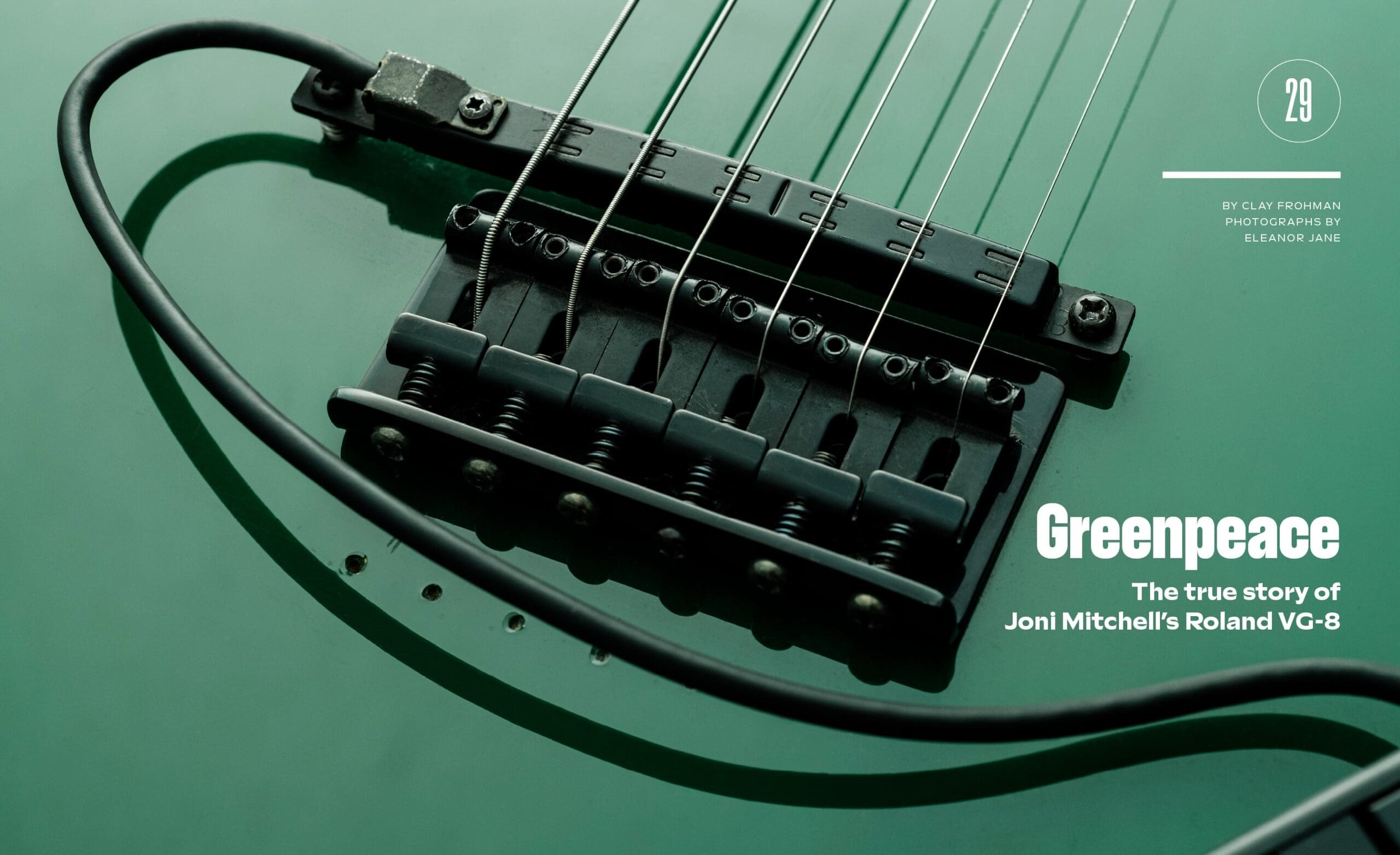
Joni Mitchell has always pushed the boundaries of songcraft and guitar playing. In this issue’s cover story, writer Clay Frohman describes how, in the mid-‘90s, with some help courtesy of Westwood Music’s Fred Walecki, Joni explored the limits of guitar tech and tuning with the help of a Roland VG-8 synth. Acclaimed guitar photographer Eleanor Jane takes pictures of Joni’s actual rig, from the VG-8 to the guitar Walecki built for her.
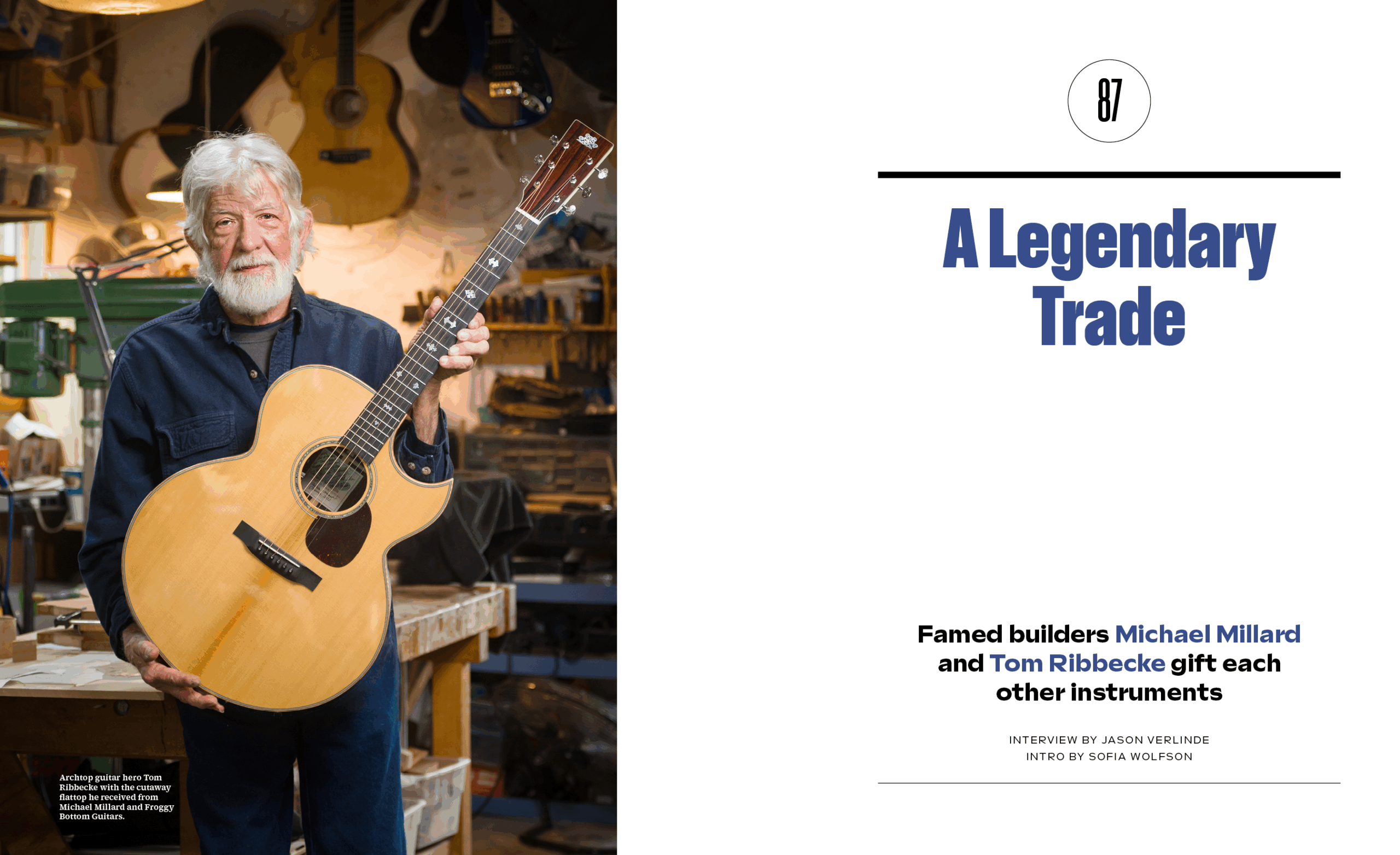
California’s Tom Ribbecke is known for his cutting-edge archtop and bass creations. Vermont’s Michael Millard is a bit more old school; he’s the mastermind behind legendary acoustic flattop company Froggy Bottom Guitars. Fretboard Journal founder Jason Verlinde talks to these decades-old friends about the guitars they just built for each other in the instrument trade of a lifetime.
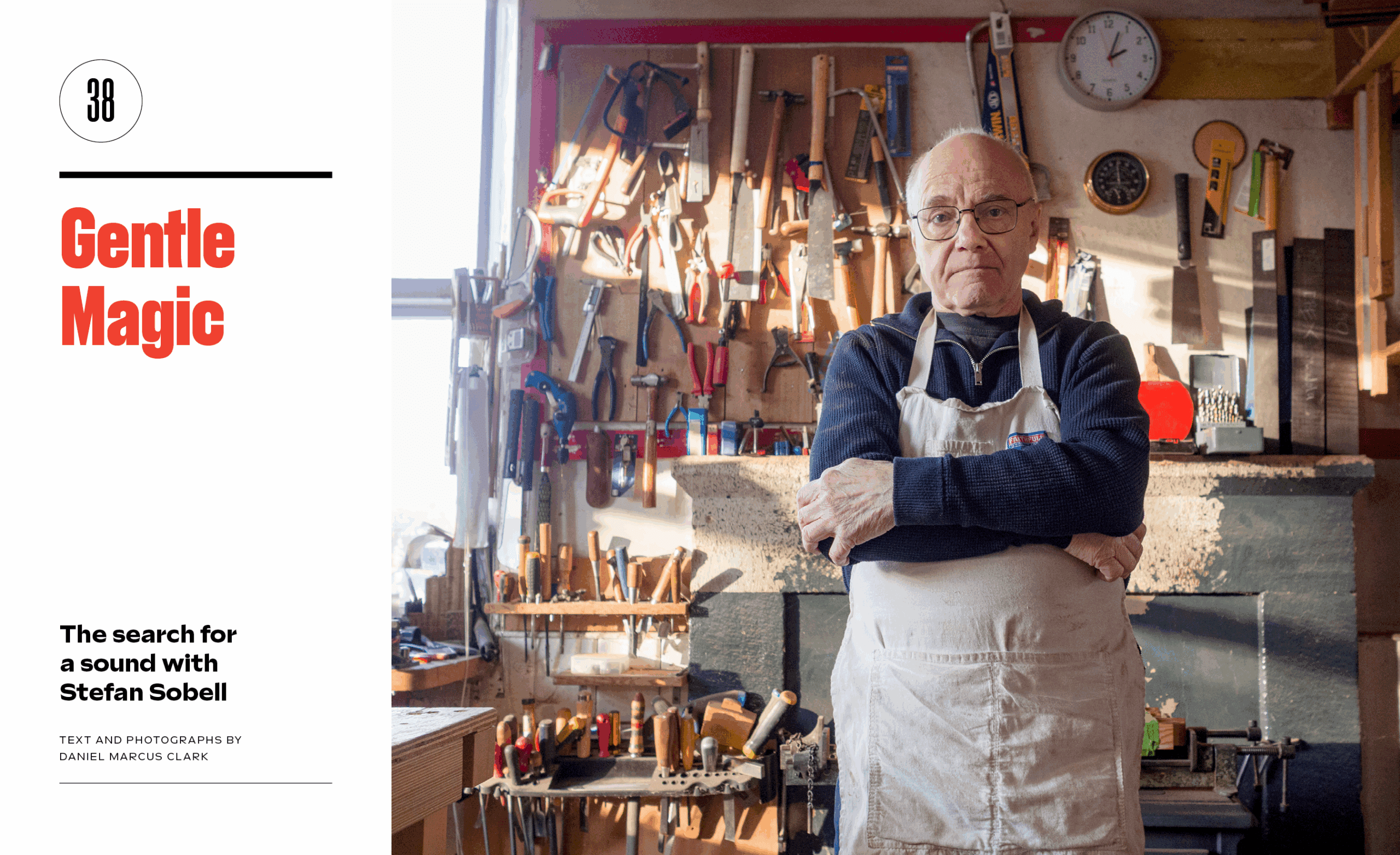
Contributor Daniel Marcus Clark interviews acclaimed UK-based luthier Stefan Sobell about his craft. Sobell is one of those rare stringed artisans who makes nearly everything, including acoustic guitars, citterns, mandolins and bouzoukis.
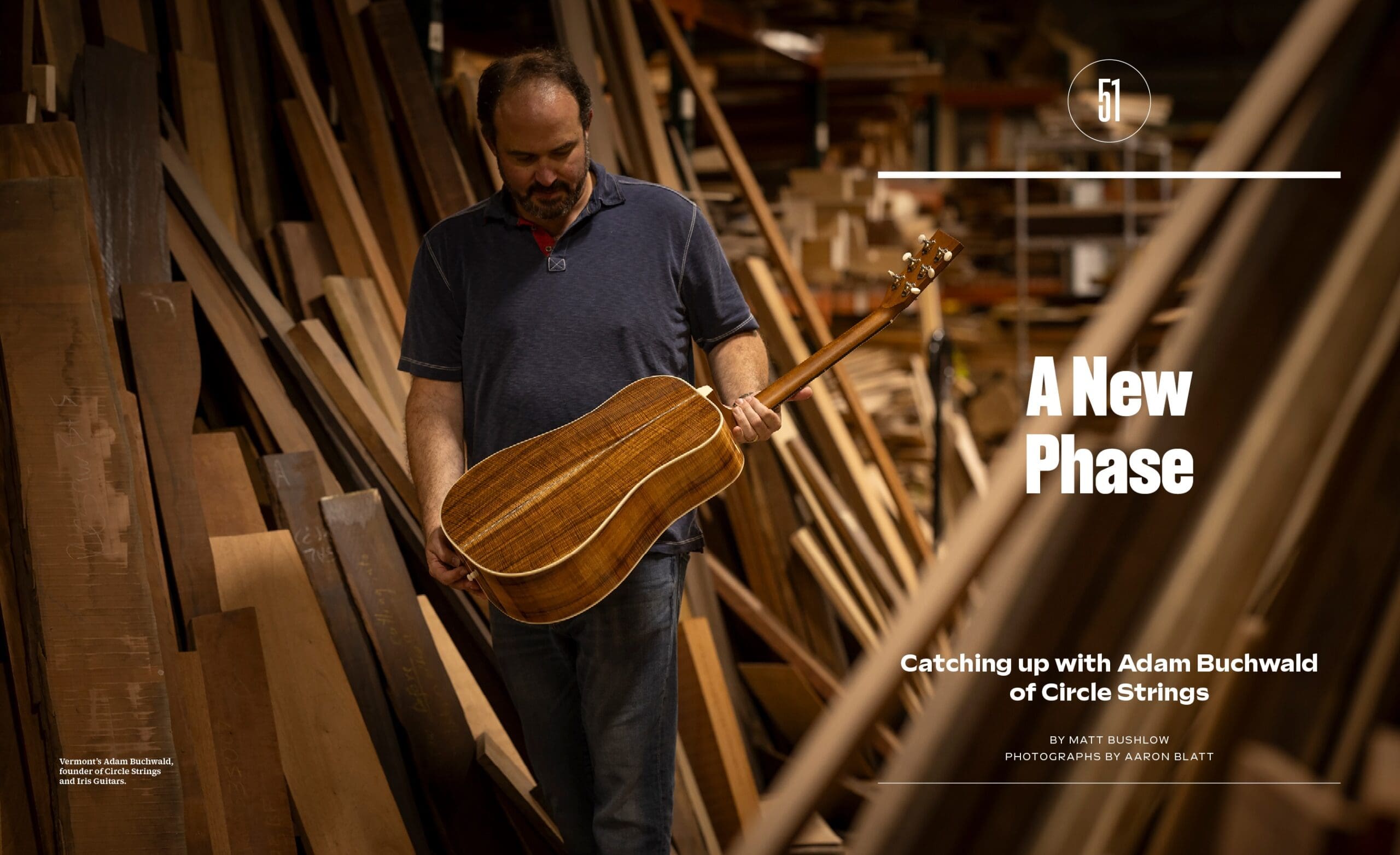
Vermont’s Adam Buchwald has not-so-quietly built one of the fastest-growing guitar companies around. Starting with his high-end Circle Strings imprint, Adam then segued into the budget-minded Iris brand, and is now the current owner of industry suppliers Allied Instruments and Gurian Instruments. Writer Matt Bushlow visits Buchwald and his expansive team at their Burlington headquarters to hear about this mini empire in the fretted instrument space. Photographer Aaron Blatt takes pics of Adam and his team.
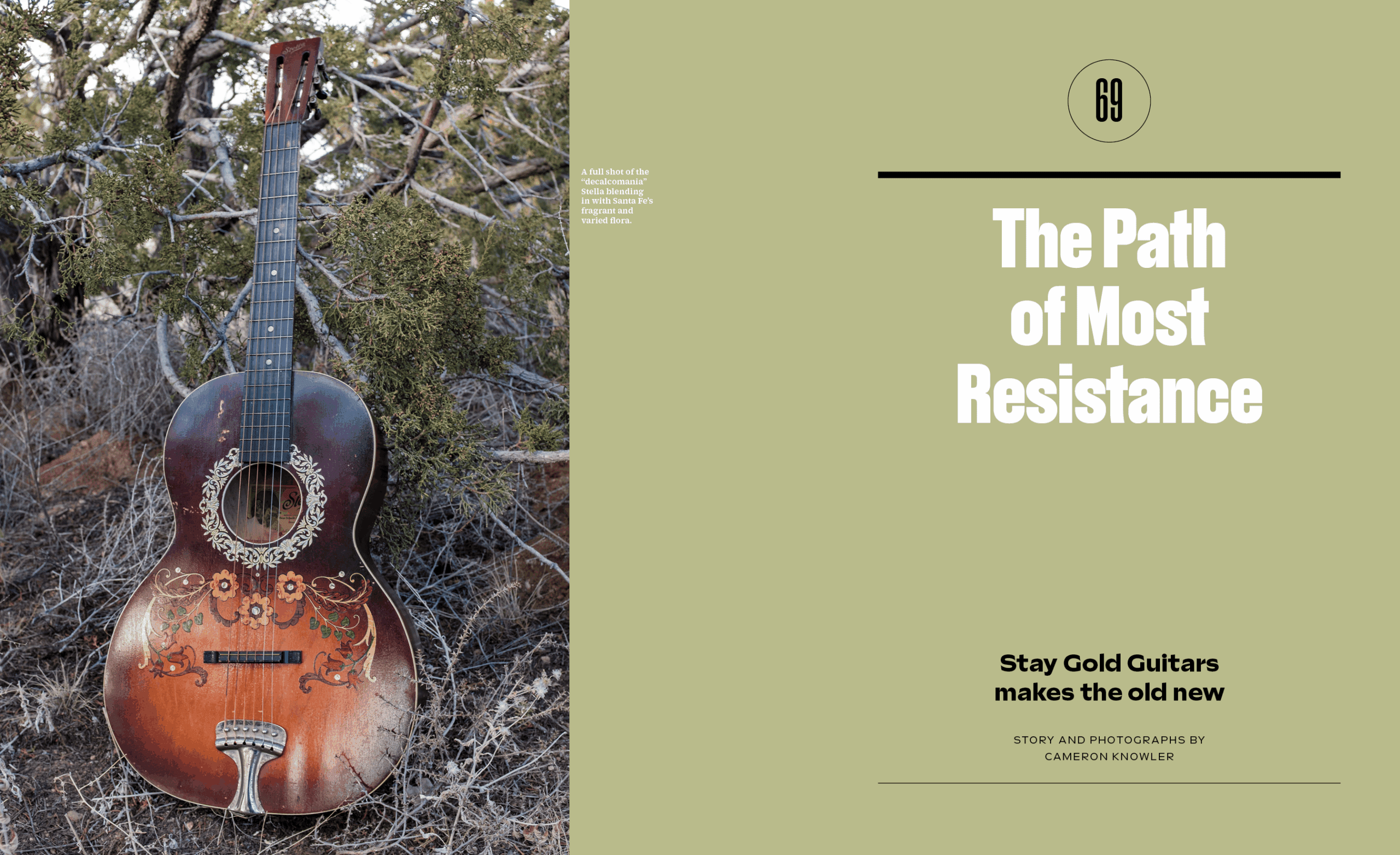
Call it upcycling or maybe hot-rodding. Cameron Knowler interviews Shawn Lee of New Mexico’s Stay Gold Guitars, a store that specializes in taking vintage (but lesser-value) American-made acoustics and rebuilding them for greatness. It’s a place where old Harmony, Bruno and Regal instruments get a second life.
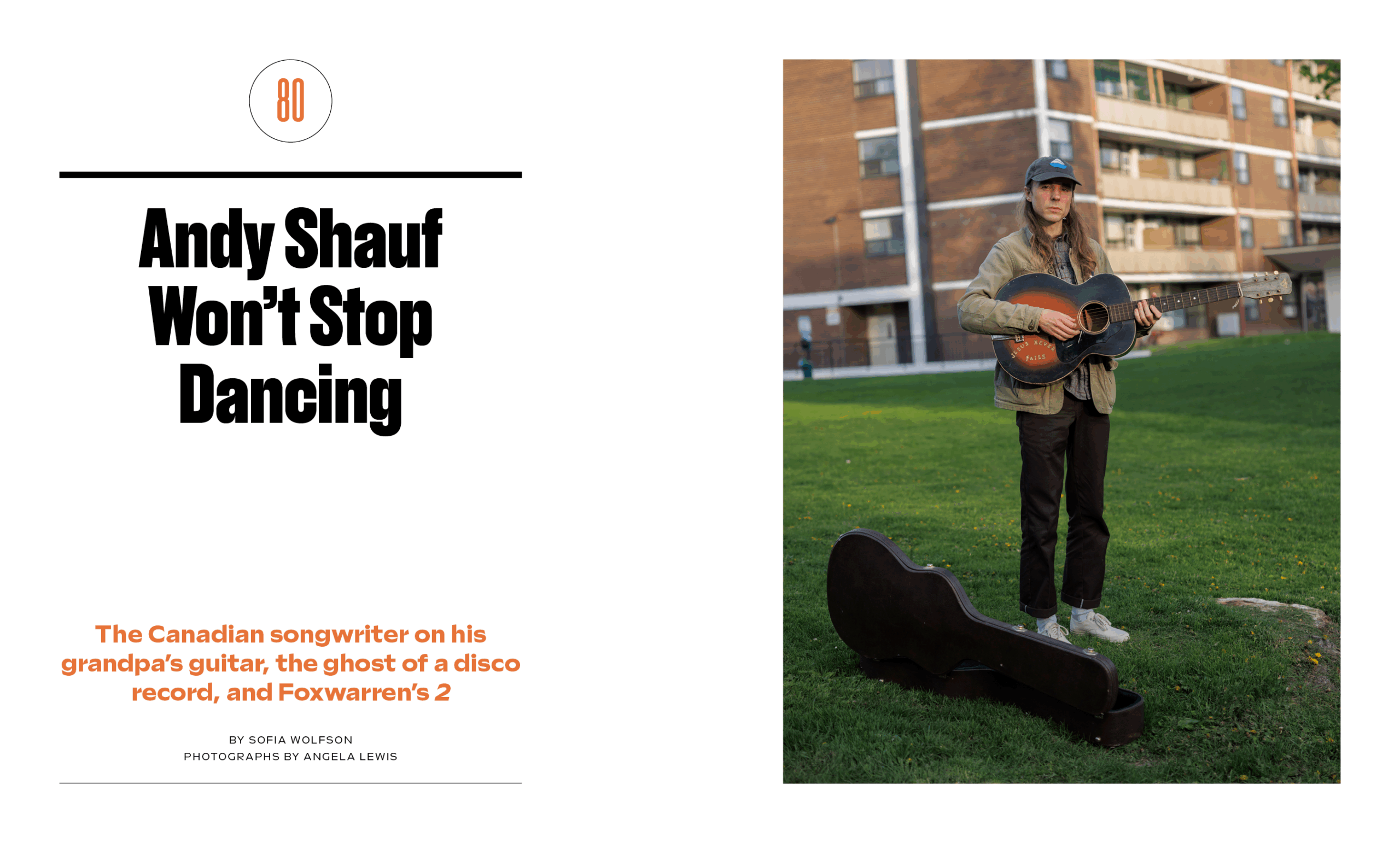
The Fretboard Journal’s Sofia Wolfson interviews singer-songwriter Andy Shauf, a Canadian-born musician with a knack for beautifully orchestrated pop songs. Shauf talks about his creative process and 2, the new album from his band Foxwarren.
Plus Maine folk artist Gordon Bok, vintage Martins, painted cases, and tons of surprises.
Thanks to our community of subscribers, contributors, and sponsors for helping make this issue a reality.
Want this issue? Subscribe today and we’ll send it to you.
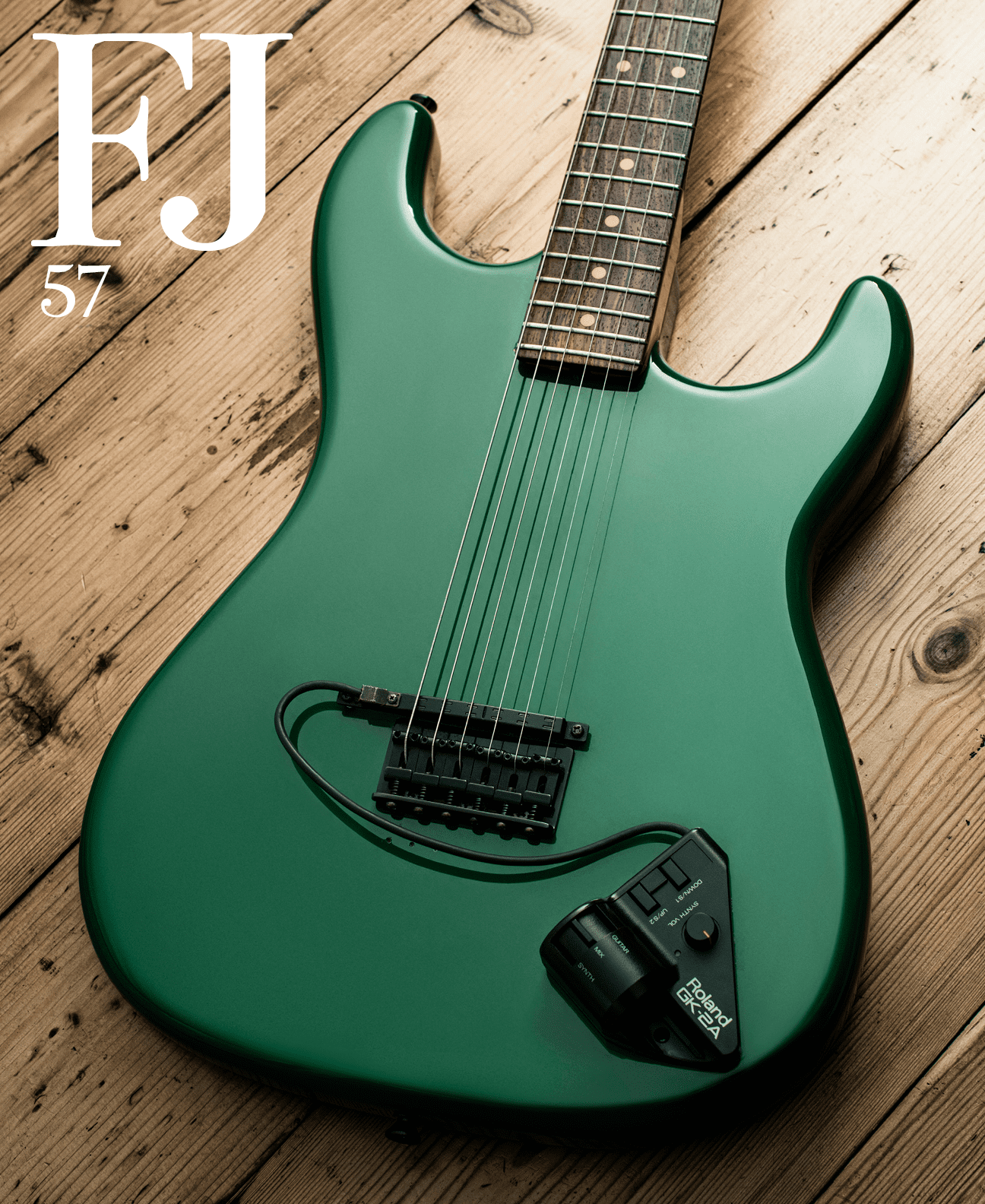
The post What’s Inside: Fretboard Journal 57 first appeared on Fretboard Journal.
Rhpf Electronics Introduces The Twin Peaks Eiger-Mönch
Two purpose-voiced delay lines that can run in parallel or interact in a true cascade. Built to transform delay from a passing effect to a core element, shaping time, sculpting space, and unlocking textures never heard before.
RhPf Electronics has introduced the Twin Peaks Eiger-Mönch, a dual-delay pedal that reimagines how guitarists use time-based effects. No tap-tempo divisions or glitch tricks; instead, two distinct voices interact in musical and inspiring ways. One line is bright and articulate, the other warm and lush. Each has its own Rate and Repeats controls so players can shape complementary echoes that blend or collide.
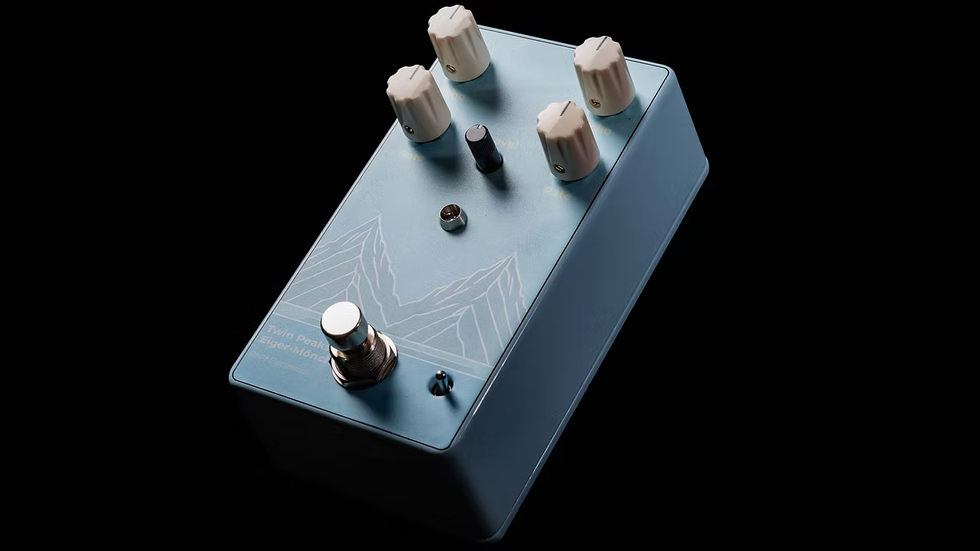
Twin Peaks Eiger-Mönch highlights include:
- Two distinct voices: warm and lush, plus bright and articulate. Each with independent Rate and Repeats.
- Parallel mode: wide, layered echoes that stay open and defined; stereo-like depth from a mono rig.
- Cascade mode: true cross-feedback so each line feeds the other; repeats intertwine and evolve into living textures.
- Designed to stay on: from subtle ambience and slapback to dub-style syncopation, always mix friendly.
- Musical feedback range: carefully tuned to avoid runaway oscillation and gimmicks.
Like every RhPf pedal, Twin Peaks Eiger-Mönch is not a clone, a mod, or a tweak. It is an original circuit designed from the ground up to be a constant companion that can become part of a player’s signature sound.
The Twin Peaks Eiger-Mönch carries a street price of $190 and is available now at select retailers and directly from RhPf Electronics.
The Who Rig Rundown
The Who need no introduction, so let’s get to the good stuff: PG’s John Bohlinger caught up with the band’s farewell tour at Fenway Park in Boston, where guitarist Pete Townshend’s tech Simon Law and bassist Jon Button’s tech Joel Ashton gave him a look at the gear that the infamous British rockers are trusting for their goodbye gigs celebrating 60-plus years together.
Brought to you by D’Addario.
Townshend’s Most Trusted
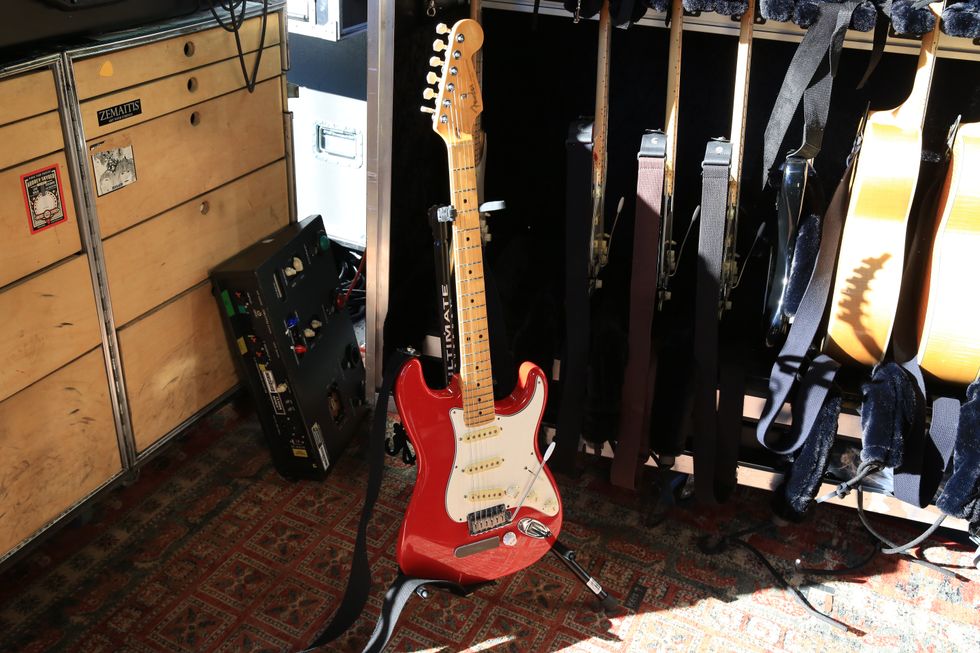
This is Townshend’s No. 1 on this end-days run. Originally an Eric Clapton Signature Stratocaster (the identifying headstock stamp has been scraped off), Law says the body and neck have been changed 10 times, and bigger frets installed. Townshend’s preferred settings are marked on the guitar and knobs.
Other mods include a Piezo bridge with a separate volume control, a stereo socket output, and a blend to mix Piezo signal with the pickups, which are Fender Noiseless models. It also has locking tuners and the Clapton mid-boost circuit, but perhaps most interesting of all is a small piece of emory board glued behind the bridge, utilized by Townshend to rough up the edges of his picks.
Stepped-Down Strat
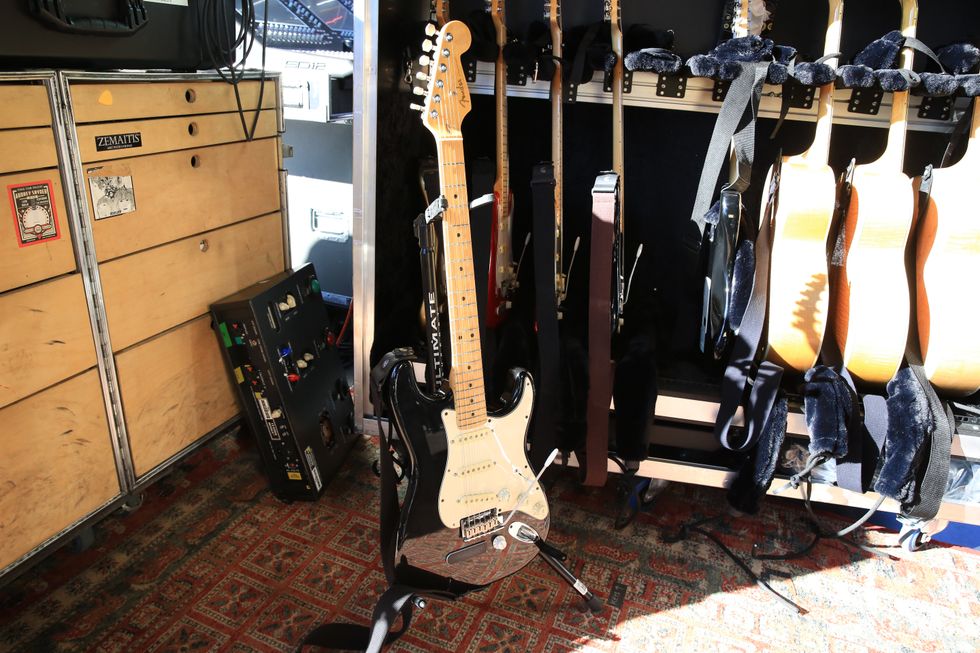
This black Strat comes out for songs in E-flat tuning.
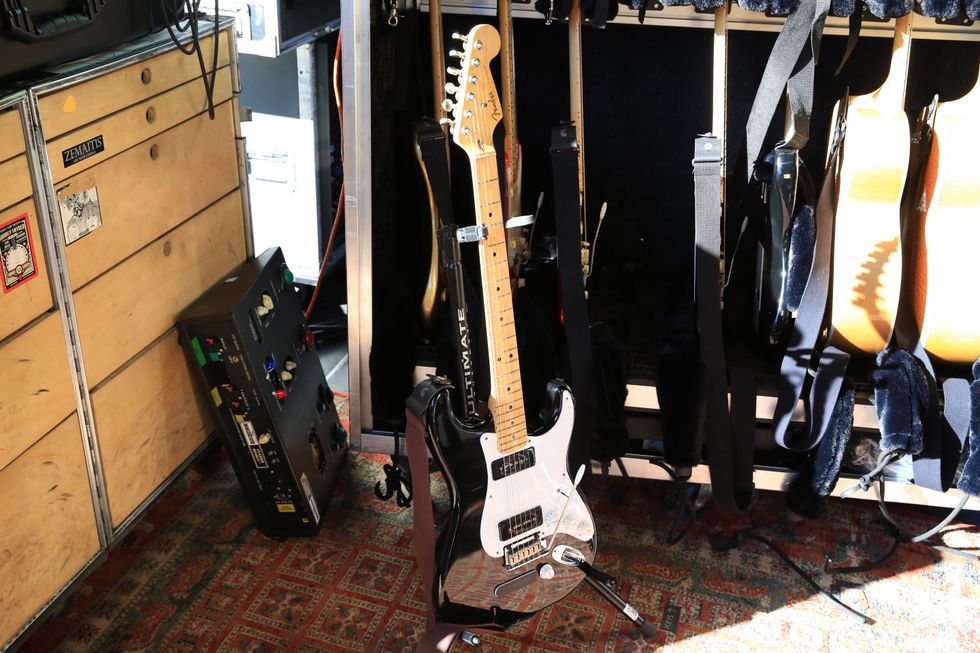
This skinny-fret Strat is loaded with P-90s in the bridge and neck, but the neck pickup is purely cosmetic—unwired and used as a killswitch.
The Quiet One
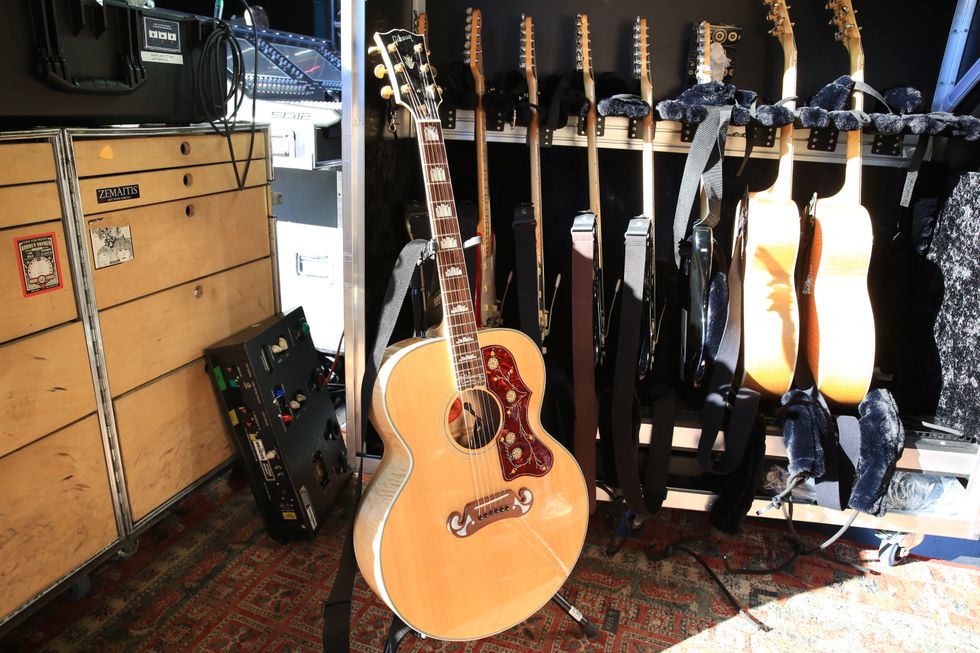
Townshend has been using Gibson J-200s forever, and this ’90s model has a Fishman Ellipse system, plus a Piezo under the bridge. It’s in standard tuning, while a signature-model backup lives in D–G–D–G–B–C. The backup has D’Addario strings (.012–.056) while the main axe has .012–.053 D’Addarios.
Addition from Alessandro
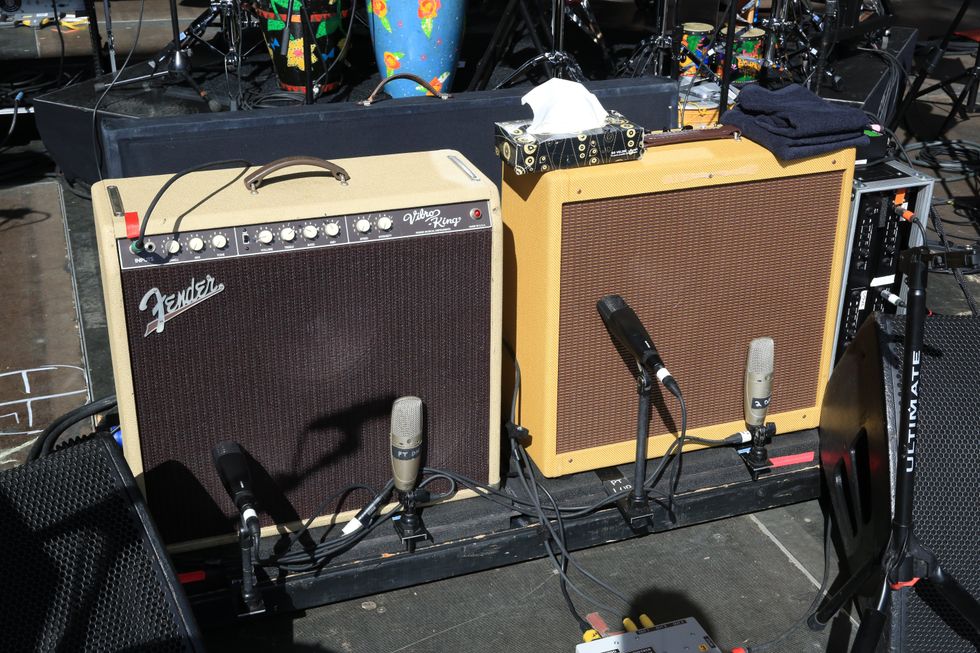
Townshend has been relying on Fender Vibro-Kings since the ’90s, and this one’s been treated to new filter caps, speakers, pots, and tubes. Law notes it’s fiddly to dial in, but always sounds great. Usually, Townshend runs a 2x12 cabinet beside it, but a desire for more control led them to have George Alessandro construct a Fender Bandmaster replica, with a 2x12 configuration.
Pete Townshend’s Pedalboard
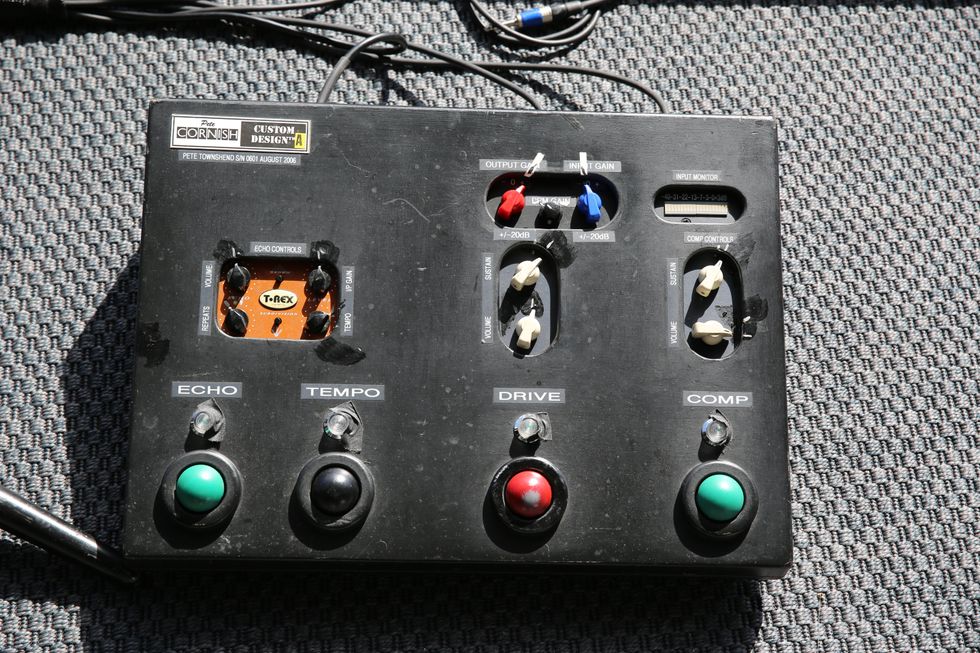
Pete’s guitars run into a Pete Cornish AC Powered 3 Way Split box, then onto a very custom Cornish-built pedalboard. Inside are just three circuits, pulled from their enclosures and wired up by Cornish: a T-Rex Effects Replica, a Boss OD-1, and a Demeter Compulator. Simon Law’s predecessor, lifelong Townshend tech Alan Rogan, had Cornish build two of these; the backup stays on hand in case of emergency. The board is also outfitted with a top-notch power supply and buffer circuit, plus the nifty “Dr. Who-style” footswitch buttons.
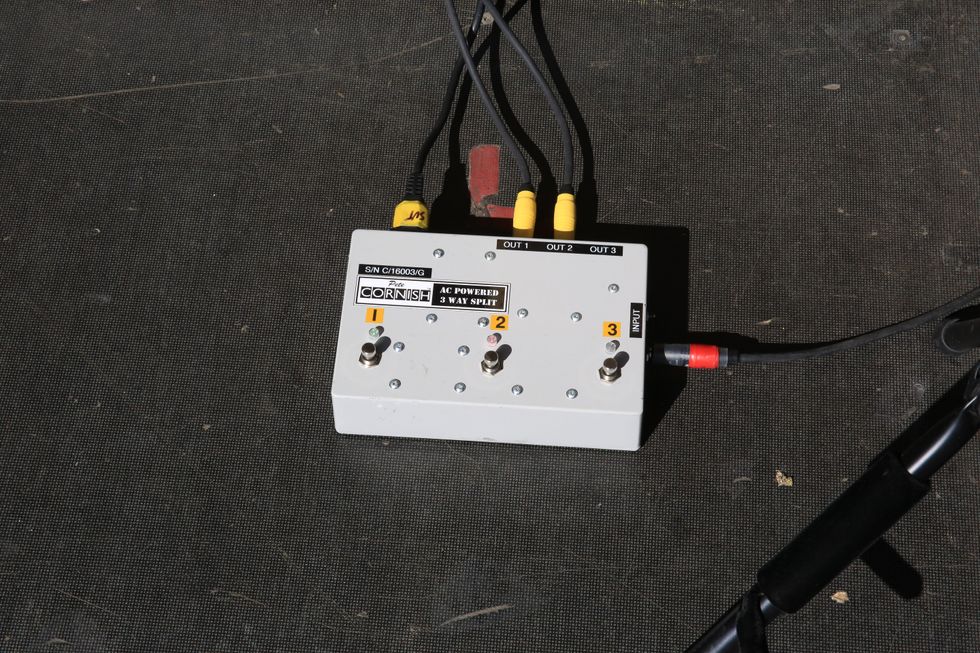
Button’s Best
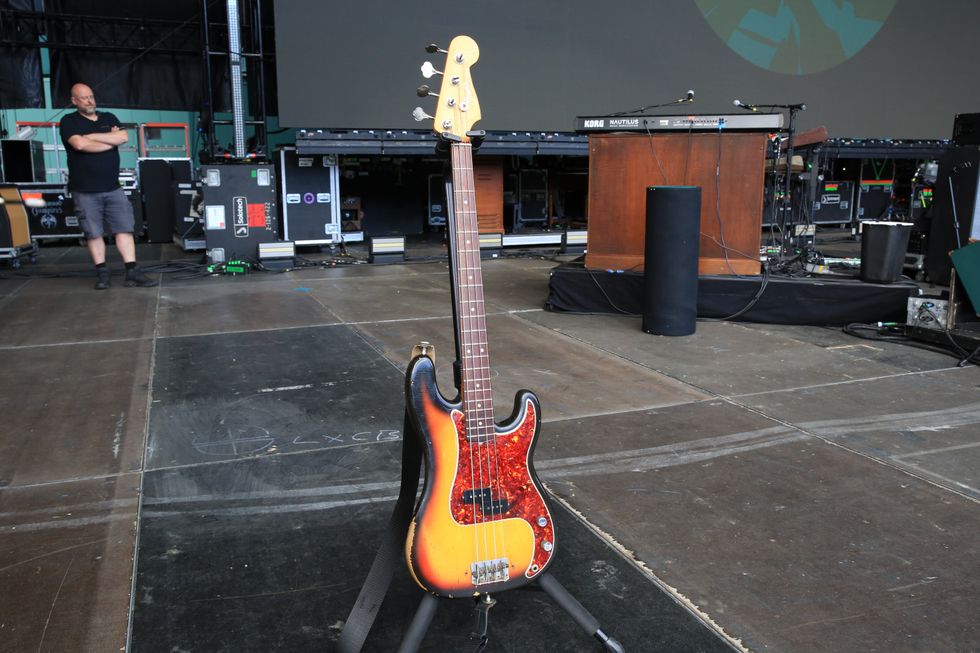
This bass, says Button’s tech Joel Ashton, is perfect. Snagged by Button in the late ’90s in Hollywood, it’s a 1965 Precision that’s been beautifully aged, and is generally used for the entire show. It’s kitted out with a Hipshot system on the D string (which drops to D flat for “Eminence Front”) and Apex strings, which Button strikes with both picks and fingers.
Mega-Monitor
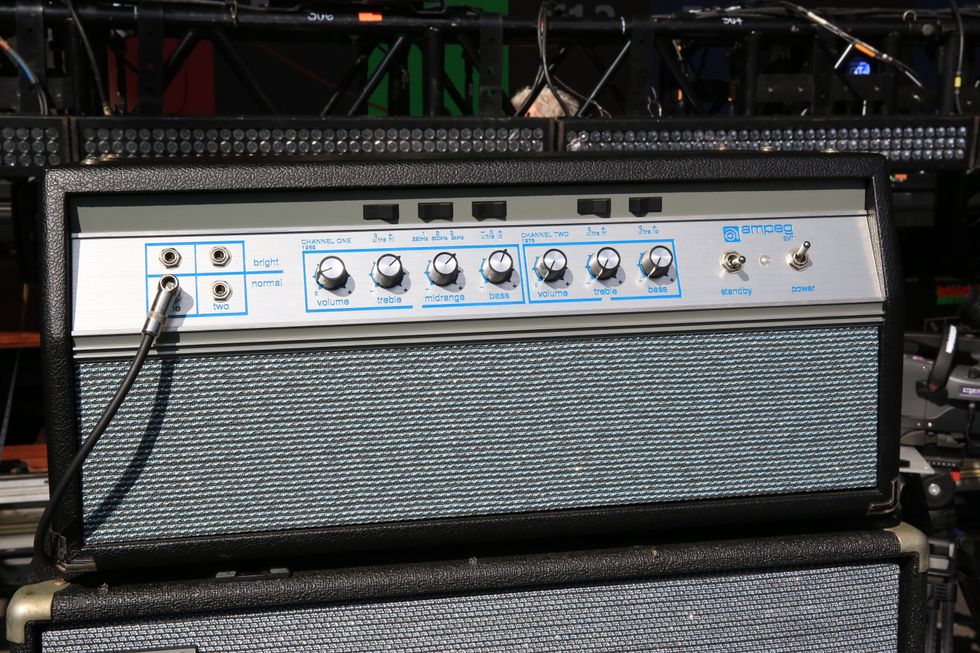
This classic Ampeg SVT is used solely as an onstage monitor for Button.
Jon Button’s Pedalboard
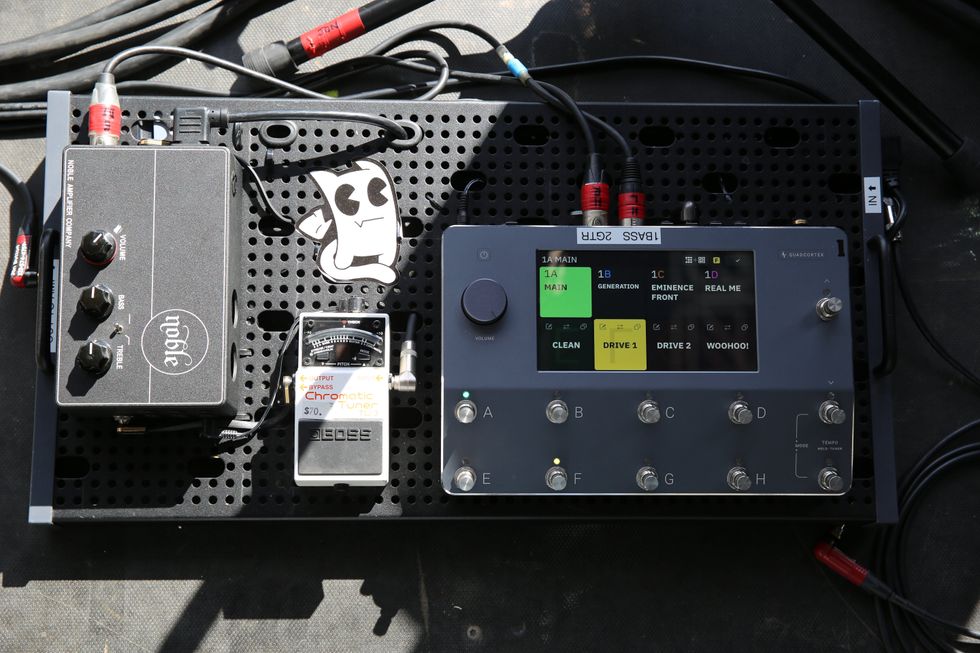
Button runs three signals to front of house: one from his Noble Preamp, and two from his Neural Quad Cortex. One of the Neural’s signals runs a stock Ampeg SVT model, and the other is an emulation of Pete Thorn’s Suhr SL68, plus four preset drive levels that Button can switch between as desired. Front of house blends the signals as they see fit.

Reverb Therapy, Part 1
Reverb is one of the most powerful colors in our palette. We all know that moment when you feel the need to add some to your tracks—whether you’re recording and looking for an inspiring new dimension, or you’re mixing and require that extra touch of spatial magic. But why are there so many options? With literally hundreds of convolution, algorithmic, plate, and spring reverbs out there, it’s easy to feel an overwhelming sense of anxiety. Knowing the differences between types of reverbs and why certain units have become legendary can significantly elevate your recordings and mixes. Tighten your belts, the Dojo is now open.
The Starting Point
I’m going to sidestep the deeply fascinating and well-researched physics and psychoacoustics behind the phenomena of reverb. Instead, we’ll focus on practical strategies for how to choose the right one (plate, spring, algorithmic or convolution), and why some types are more prized than others.
Unless you’re situated in an anechoic chamber or an open field, every environment, from a hall closet to a canyon, has reverberant properties. But before the advent of reverb chambers and plate reverbs, it was a fixed byproduct of the space where the recording took place—think of the 1961 concert document, Miles Davis at Carnegie Hall, for example. Not all concert halls lent themselves to studio quality recordings, though, especially for genres of music other than classical or opera.
After 1947, the only way to add artificial reverb was to employ a chamber—literally, a specially built room with a speaker and microphone(s). Recording studios started to develop their own echo chambers that gave a unique sonic fingerprint to the recordings, and we still prize certain studios—Abbey Road, Ocean Way, Blackbird, Motown, Sound City— for their chambers, many of which are now available in the forms of plugins.
All that began to change in 1957, in Berlin, with the advent of the EMT 140 plate reverb. EMT’s solution was brilliant: suspend a large sheet of steel under tension, feed sound into it through a transducer, and capture the shimmering decay with contact mics. The EMT 140 gave engineers long, smooth tails that felt lush without overwhelming the source. Vocals in particular took on a glow that instantly elevated a mix. That unmistakable “plate vocal sound” defined the recordings of countless artists, from Frank Sinatra to the Beatles to Jimi Hendrix to Pink Floyd. Even today, plug-in makers such as Universal Audio, Waves, and Arturia are still chasing that magic, and multiple original units are still widely used by world-class studios.
“Unless you’re situated in an anechoic chamber or an open field, every environment, from a hall closet to a canyon, has reverberant properties.”
Fast forward to 1976, and EMT again pushed things forward with the EMT 250, the first commercially available digital reverb—for the princely price of $20,000 (over $114,000 today). Only 250 units—a mini refrigerator-sized machine with controls that looked like they came off the dashboard of a spaceship—were produced. What made the EMT 250 special wasn’t just its novelty, but the way its algorithms shaped reflections. It had a character all its own: warm, slightly grainy, and wonderfully musical. Almost a proto mutli-effects processor, it didn’t try to mimic reality so much as create a believable illusion of space, and it did so with a tremendous personality. (The EMT 250 is currently available from Universal Audio as a plug-in for $249 street.)
Meanwhile, across the ocean in Massachusetts, Lexicon was hard at work refining digital reverberation. The Lexicon 224 (1978) was half the price of the EMT 250 and boasted a reverb range of 0.6 to 70 seconds. It also offered the first flexible and convincing Concert Hall, Chamber, Room, Plate, Rich Plate, and Inverse algorithms. It was the studio reverb of choice until the 480L (1986) which, with its updated signal processing power, became the studio staple—and for good reason. Chances are it’s the main big reverb on classic U2, Talking Heads, Rush, Prince, and Peter Gabriel records. The 480L’s algorithms remain benchmarks: dense, lush, and capable of everything from subtle ambience to stadium-like grandeur. Even today, if you walk into a top-tier studio, odds are a 480L is still patched in.
I encourage you to set aside some time and get to know the differences between these four classic verbs, before we move on to another set in the next installment. They are all available in plugin format with fully functional trial periods. I’ll share my favorite reverbs in order of preference and application next month. Until then, namaste.
Peavey Rock Master Preamp Pedal Imposes Its Presence onto the Pedal Board
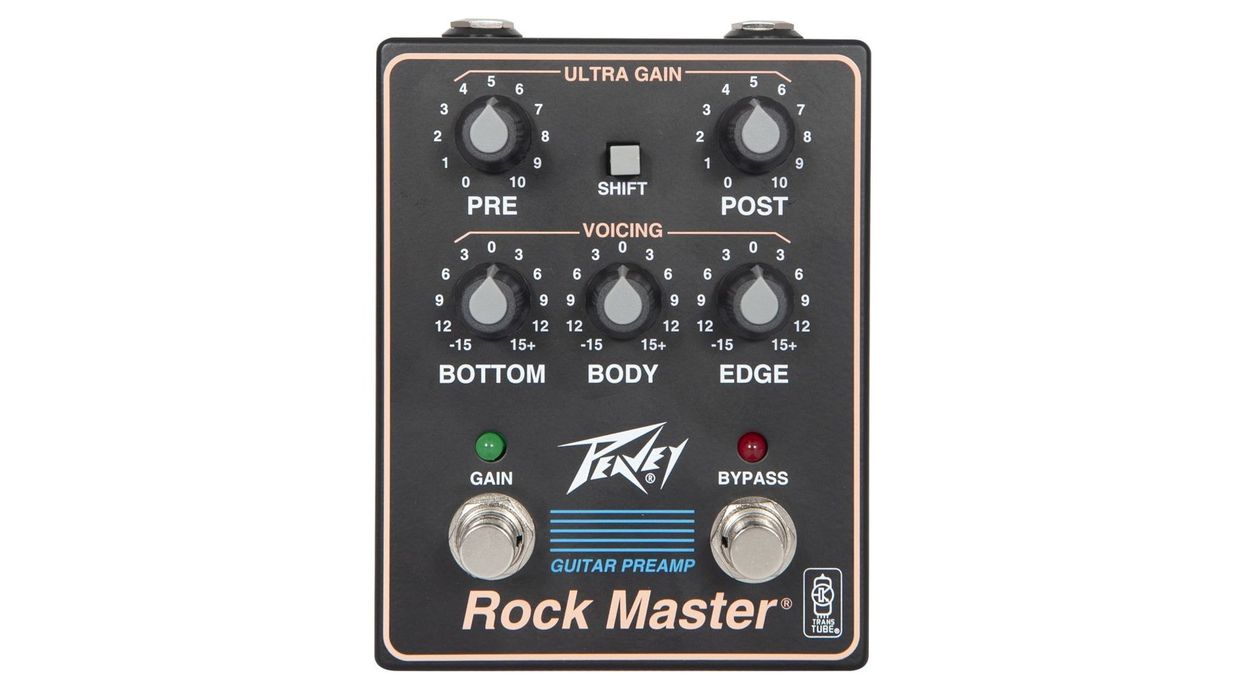
Peavey Electronics® is now shipping the latest in their new Legacy Series of pedals, the Rock Master® preamp pedal. This pedal delivers the highly sought after Ultra Gain tones of the early 90’s Rock Master Guitar Tube Preamp in a compact package small enough to fit in your back pocket. The pedal is now available worldwide through local and online retailers.
The original Rock Master Guitar Tube Preamp is what some consider to be the granddaddy of what became the Peavey XXX and JSX guitar amplifiers. Most notably, the Ultra gain section. The new Rock Master preamp pedal focuses on this Ultra Gain section and the units Voicing EQ. The units PRE and POST gain controls allow the user to control the amount of gain applied to the input signal via the PRE control and the overall output volume via the POST control. The active three band EQ/Voicing section allows players to fine tune their overall tone with BOTTOM, BODY, and EDGE controls. As it implies, the BOTTOM control is an active +/- 15dB shelving type tone control that varies the low frequency boost or cut. The BODY control is an active, peak/notch +/- 15dB tone control that varies the mid frequency boost or cut. And the EDGE is an active +/- shelving type control varying the high frequency boost and cut. Internally, it is Peavey’s TransTube® technology that brings it all together to create that groundbreaking Peavey Rock Master “Ultra” channel circuit.
Construction of the pedal uses a die-cast metal enclosure, fiberglass PCBs with 2-ounce copper and plated through holes on all components, high quality pots, switches, and jacks, and cosmetics reflecting the original preamp that influenced a whole generation of guitar amplifiers. The pedal can be used with either a 9v power supply or battery.
For more information, please visit www.Peavey.com
Retail: $199.99 USD
Fingerstyle Blues Workout—Explore the Rhythmic Power and Melodic Potential of Dropped-D Tuning
Say goodbye to hours of painful tone tweaking: Positive Grid’s new BIAS X platform uses AI to deliver the perfect guitar tone instantly

Sick of endless knob-fiddling to get that perfect tone? Positive Grid’s latest AI-powered guitar tone platform BIAS X is here to change that. Available for Mac and PC, BIAS X combines cutting-edge AI with a next-generation tone engine, taking musicians from a spark of an idea to a mix-ready sound in just moments.
From subtle dynamics and soaring leads to punchy modern metal and dreamy ambient swells, BIAS X delivers tones with an authenticity that mirrors real tubes, speakers, and circuits. Whether used as a standalone tone lab or as a DAW plugin, BIAS X is designed to help players spend more time making music and less time fiddling with settings.
What really sets BIAS X apart is its use of agentic AI, which is said to “understand tone like a musician”. Players can describe the sound they want – via text prompts referencing a favourite artist, song, genre, or even an abstract feeling – and the software generates a matching tone almost instantly. Musicians can also upload audio clips to recreate tones or request iterative refinements such as “more bite,” “less fuzz,” or “add crunch”. This dramatically streamlines the creative workflow, which is clearly one of BIAS X’s primary goals.
The platform itself comes equipped with 33 amps, 62 effects, and an all-new cab simulation. All of which have been crafted with an advanced tone engine that combines decades of Positive Grid’s amp and effects modelling expertise with machine learning and circuit-level simulation.
Over 200 classic amps were analysed during development to capture their tonal character, while adaptive circuit modelling and harmonic fingerprinting ensure that every note responds dynamically to a guitarist’s pick, volume, and playing style.
BIAS X also features an intuitive, drag-and-drop interface – reminiscent of Positive Grid’s popular BIAS FX 2 amp and effects suite – that encourages fast experimentation without breaking creative flow. Musicians can easily mix and match amps, cabinets, and effects to build custom rigs, while the revamped preset manager and gear browser make it simple to recall, compare, or swap gear on the fly.
As with all AI learning models, BIAS X evolves with the user, which means it will, in theory, adapt to your preferred style and preferences the more you play.
BIAS X is available for $149. Check out the software in action below.
Learn more at Positive Grid.
The post Say goodbye to hours of painful tone tweaking: Positive Grid’s new BIAS X platform uses AI to deliver the perfect guitar tone instantly appeared first on Guitar.com | All Things Guitar.
“We knew there was going to be quite a bit of scrutiny”: Jake Kiszka felt “pressure” at what Greta Van Fleet fans would think of his Mirador side project

Jake Kiszka says he was prepared to face some scrutiny when releasing music for his new project, Mirador, from the fans who came to know him in Greta Van Fleet.
Launching Mirador has allowed Kiszka to make music without his brothers and GVF bandmates – Josh and Sam Kiszka – for the first time. He’s teamed up with Ida Mae’s Chris Turpin for the project, and the pair released their self-titled debut album earlier this month.
Opening up on the formation of Mirador, Kiskza tells SPIN, “There was some pressure around that, especially to begin with. We knew that if this was going to be a thing, there was going to be quite a bit of scrutiny around it from Ida Mae fans and Greta Van Fleet fans and everybody.
“In one way or another, there’s a skepticism about it. We really have to show up. We really have to deliver. In one way, as a promise to ourselves. But in another way, it was trying to do our best to represent this idea. It was trying to show people not only Mirador as a band, but that it exists because of this relationship and friendship and brotherhood. That’s part of the story. The reason we did this to begin with was because the philosophy, what Mirador means, transcends the music,” he states.
Further speaking on the differences in communication between the Greta Van Fleet camp and his work with Turpin, Kiszka adds: “The creative input is coming from four different sides of the table [in GVF]. There’s a stark contrast because there’s so many ideas. You’re really chasing a moving target, and that’s exciting, and it’s exhilarating, and it holds its place within the chemistry of Greta Van Fleet. But I’d never really worked with another person outside of my brothers.”
He continues, “That creative kinship is a rare thing. I have written or worked with other people where we’re seeing eye-to-eye to a certain degree, but not completing the other one’s sentences. It really started with a guitar, the phrasing. It was evident we were coming from the same place, that we spoke the same language, that our musicality and that vernacular was going to be shared and intertwined, because it was that way with the guitars.
“There was no question that if we could play together like that, with that kind of chemistry, we were of one mind. It was two people locked into one thing. I never had that before…. An interesting contrast to what I’ve been used to.”
The debut album from Mirador is out now, and you can also catch them on tour from September-November this year.
The post “We knew there was going to be quite a bit of scrutiny”: Jake Kiszka felt “pressure” at what Greta Van Fleet fans would think of his Mirador side project appeared first on Guitar.com | All Things Guitar.
Andrew Watt is producing another Rolling Stones album: “It’s like working for Batman… When the tongue is up in the air, you just go”

Producer Andrew Watt is working with the Rolling Stones again, as he confirms that they’ve been recording new music together.
Watt produced the band’s Grammy-winning 2023 album Hackney Diamonds, and has since gone on to produce for Pearl Jam, Lady Gaga, and for the collaborative album, Who Believes In Angels?, released by Elton John and Brandi Carlile earlier this year.
Though remaining very tight-lipped on the fine details, producer Watt tells Rolling Stone, “I’ve said it before, but it’s like working for Batman. When the tongue [logo] is up in the air, you just go… I can say we did some recording together, but that’s all I can say.”
Watt’s involvement in what sure seems to be another full-length record comes after speculative reports from inside sources, which suggested the band had been spending time in the studio again, and a Record Collector interview with Keith Richards’ son, Marlon.
He told the outlet that the band were “nearly done” recording and that they had enough material left over from Hackney Diamonds to work with on a new project: “They have enough left over from the last one. [It] gave them a Grammy so now they’re all hyped up on that: ‘Oh, yeah – we can do another one like that! We’ve got more like that if you want…’. I think they’re doing the follow-up,” he said.
Watt reflected on the making of Hackney Diamonds earlier this year, sharing his pride in how Paul McCartney helped him to land the gig, and how the Beatle got involved on the record for track Bite My Head Off.
“He got to just be the bass player in the band, and he fucking loved it,” Watt told Mojo. “As I was walking Paul out of the studio, he said, ‘I just fucking played bass in The Rolling Stones, and I’m a fucking Beatle!’”
The post Andrew Watt is producing another Rolling Stones album: “It’s like working for Batman… When the tongue is up in the air, you just go” appeared first on Guitar.com | All Things Guitar.
I tried using an AI-powered amp and effects suite to create my guitar sound for me – here’s what happened

Ad feature with Positive Grid
The guitar world is a place where true innovation often feels hard to come by – after all, a lot of the technology used to make guitars, amps and effects do what they do is many decades old.
Positive Grid has been trying to change that in recent years, and the brand’s revolutionary Spark smart amp has changed the game for thousands of guitar players who want to streamline and simplify their practice routine.
Now the brand is looking to make the tone-sculpting experience even more frictionless in its impressive new amp and effects software suite, Project: BIAS X – and it’s doing it with the help of 2025’s main character: AI.
One of the most common complaints about any kind of comprehensive amp and effects product is that the sheer volume of options can act as a hindrance to creativity. Option paralysis is a real thing, and how often have we got distracted auditioning different amps and effects instead of actually making music? It can be fun, but it’s not always productive.
 Image: Positive Grid
Image: Positive Grid
As you’d expect, BIAS X is a hugely powerful tool for in-the-box guitarists, offering over a hundred brilliantly modelled amps, cabs and effects, and all the signal-routing options you could dream of.
You could spend many hours exploring all the different sounds that are available. But for those who want to get down to it, BIAS X adds something potentially revolutionary – a chatbot-style AI Assistant that will take your prompts and attempt to turn them into the guitar sound you’re looking for in seconds.
I don’t know about you, but even as an experienced BIAS user, I often find there’s a gap between the tone I envision in my head and the one I’m able to create – especially when I\m stepping outside of my musical comfort zone.
Could BIAS X’s AI Assistant help me dial in the sound I’m looking for more easily and accurately than I could on my own? I was keen to find out, so I took the plunge?
 Image: Positive Grid
Image: Positive Grid
How do you use the AI Assistant to create tones in BIAS X?
If you’ve been on the internet at all in the last year or so, you’ll probably have had some conversations with an AI agent, and the chat window popup in BIAS X is reassuringly familiar if you have.
Rather than answering your inane questions like ChatGPT, however, BIAS X’s AI Assistant has the much more worthwhile task of taking your user prompt and using its machine learning to build a signal chain from its myriad options. Once that’s done, you can check it out and then manually tweak and refine parameters to your taste.
As Guitar.com’s resident high-gain aficionado, my first port of call is to see how the AI Assistant can handle some crushing metal tones. There are plenty of amazing classic metal amps in BIAS X, so my hopes are high.
As with any AI prompt, I find it helps to be as specific as possible to get good results – “Give me a thrash metal tone” is not likely to yield exactly what you’re after for example, given the huge scope of that particular request.
Instead, I drill down: “Give me a high-gain tone for thrash metal,” I write. “Use a gate to limit unwanted noise, and make sure it has enough clarity so I can hear many notes in quick succession.”
I wait in quiet anticipation as the Assistant tells me it is ‘dialling it in’, and barely 10 seconds later I’m presented with a shiny new preset based on my request. This is a lot quicker than building it yourself.
To my great pleasure, the tone it gives me is a gnarly, heavily driven but not muddy sound – it’s frankly, mix-ready. The only thing I really have to do is tweak BIAS X’s global gate to reduce some heavy noise, but that may be more to do with my input level than anything fundamental about the AI-generated tone itself. Did I say it did this in 10 seconds?
A big tick for metal then, but how will the AI Assistant handle something a little more nuanced – like a crunchy blues-ready lead or a delicate and immersive clean for arpeggios? And what happens if I dial back on my level of detail in the prompt?
Keeping it simple this time I simply ask, “Give me a crunchy blues lead tone” and instantly you can tell the difference. While the basic result it provides me sounds good, it definitely needs a bit of refinement to get it to where I need it to be. It’s a touch wooly for my tastes, and the mids need scooping.
Thankfully, the AI Assistant exists in a continuous chat window, so I can ask it to make whatever refinements I desire. “Keep everything the same, but apply some subtractive EQ to the 400 – 600 Hz range to reduce grating peaks,” I tell it.
And voila, not 10 more seconds later, I’m served up a refined blues tone based on more than one of my prompts that sounds so good, and has me jamming for long enough for me to forget I’m working right now on writing this article.
My only real hiccup occurs the first time I ask for a clean tone – the Assistant generating a tone that’s significantly quieter in level than the previous two generated. Again, this would be an easy enough fix, but out of interest I simply ask the same prompt again.
The power of the AI inside means that these steps are not predetermined – so there’s every chance that the Assistant will output something different each time. Second time out, I’m delivered a gorgeously ethereal and reverb-washed clean tone that’s good to go.
It’s also worth noting that in my weeks with BIAS X, the quality of response from the Assistant has improved significantly with each software update pushed out pre-release. It’s a good sign that this will get even better over time.

It’s not just about text either…
What’s more, text-to-tone is just one of two principal ways the AI Assistant can help you achieve the sound you’re after. The other, ‘music-to-tone’, is perhaps even more exciting – as it allows you to upload an audio file, which BIAS X then analyses and delivers a guitar tone based on what it hears in the track.
Giving it a go myself, I uploaded an mp3 of a royalty-free track which begins with a riff, followed by a more full instrumental. I’m asked which snippet of the song I want BIAS X to analyse – it’s generally more successful if you choose a section with less instruments surrounding the guitar.
Once again, in 10 seconds or less delivers me four presets to choose from. I did notice that these presets were often quite different, but given that the AI is trying to account for the all-important guitar-shaped variable, that’s probably for good reason. Ultimately, every time I’ve given this feature a go, at least one of the generated presets sounds scarily like the original track.
 Image: Positive Grid
Image: Positive Grid
So, do I really need an AI Assistant in my guitar software?
A lot of the conversation around AI at the moment is basically ‘Does X really need AI in it?’ but with something like BIAS X I can really see the user benefit.
The AI Assistant isn’t going to replace your need to have any kind of input in your tone-shaping endeavours – you still have to think and engage with what it’s spitting out in order for you to get the exact sound you want for your gear, playing style and needs.
Sure, you could create anything that the Assistant does yourself, but there’s no doubt that it gets you there a hell of a lot faster than the old-fashioned way. For me, it massively expedited the process of turning the sound in my head into a usable, functional guitar time, and let me focus on what really matters – making music.
Find out more about BIAS X at Positive Grid.
The post I tried using an AI-powered amp and effects suite to create my guitar sound for me – here’s what happened appeared first on Guitar.com | All Things Guitar.
“I wrote it so that Joe and I could play even harder than we did on Hotel California”: Don Felder on the guitar duel that never made Eagles’ last 70s album

Former Eagles guitarist Don Felder has re-recorded his 1981 solo cut Heavy Metal (Takin’ a Ride) for his new album, The Vault – Fifty Years of Music. The song, he reveals, has its roots in the band’s late ’70s heyday, when he envisioned it as the ultimate guitar showdown between himself and bandmate Joe Walsh.
Felder explains that the track was written in the wake of the Eagles’ career-defining Hotel California, where his traded solos with Walsh had become the stuff of legend. With The Long Run on the horizon, Felder says he wanted to push that energy even further.
“It was going to be a follow-up on The Long Run,” he tells Guitarist. “It had a real kind of heavy hand to it and I wrote it so that Joe and I could play even harder than we did – or edgier than we did – on Hotel California, against each other. It had harmony parts, trading-off solos and a much harder rock edge.”
A basic track for the song was cut during sessions for The Long Run, but deadlines (“We were just dying to get through this record,” the musician recalls) and tour commitments meant the band never finished it.
“We had a basic track, but it just died in the Eagles’ vault,” says Felder. “We just didn’t have time to do everything we needed to do. There were a lot of dropped ideas along the way, but I took the idea and turned it into Heavy Metal.”
The unfinished idea was resurrected years later when Felder was approached to contribute to the soundtrack for the animated sci-fi film Heavy Metal. Retitled Heavy Metal (Takin’ a Ride), the song found new life outside the Eagles’ orbit, but Felder has never stopped imagining what it might have sounded like as a full-blown Eagles guitar epic.
Now, more than four decades later, Felder says revisiting the track for his new album gave him the chance to finally update its sonics.
“After listening to it since 1981 or ‘82, just the tonality and the quality of it sounded kind of dated, you know? I thought, ‘I really like that song. I love playing it, and I play it at almost every one of my live shows. I just want to do a fresh version of it,’” he says.
Recorded with modern tools and production values, Felder insists the 2025 version captures the power he always heard in the song: “I used 96k Pro Tools, and with the remastering that we have today you can make things sound really great. So I went back and re-recorded it. It was fun to do and it just sounds a lot better to me.”
“Without the title Heavy Metal, that song could have, and should have, in my opinion, been finished on an Eagles record with Joe and I following up on Hotel with some dazzling guitar solos and stuff,” he says.
The post “I wrote it so that Joe and I could play even harder than we did on Hotel California”: Don Felder on the guitar duel that never made Eagles’ last 70s album appeared first on Guitar.com | All Things Guitar.
Unseen Nirvana footage from 1990 gig – where Kurt Cobain smashed two guitars – surfaces at auction
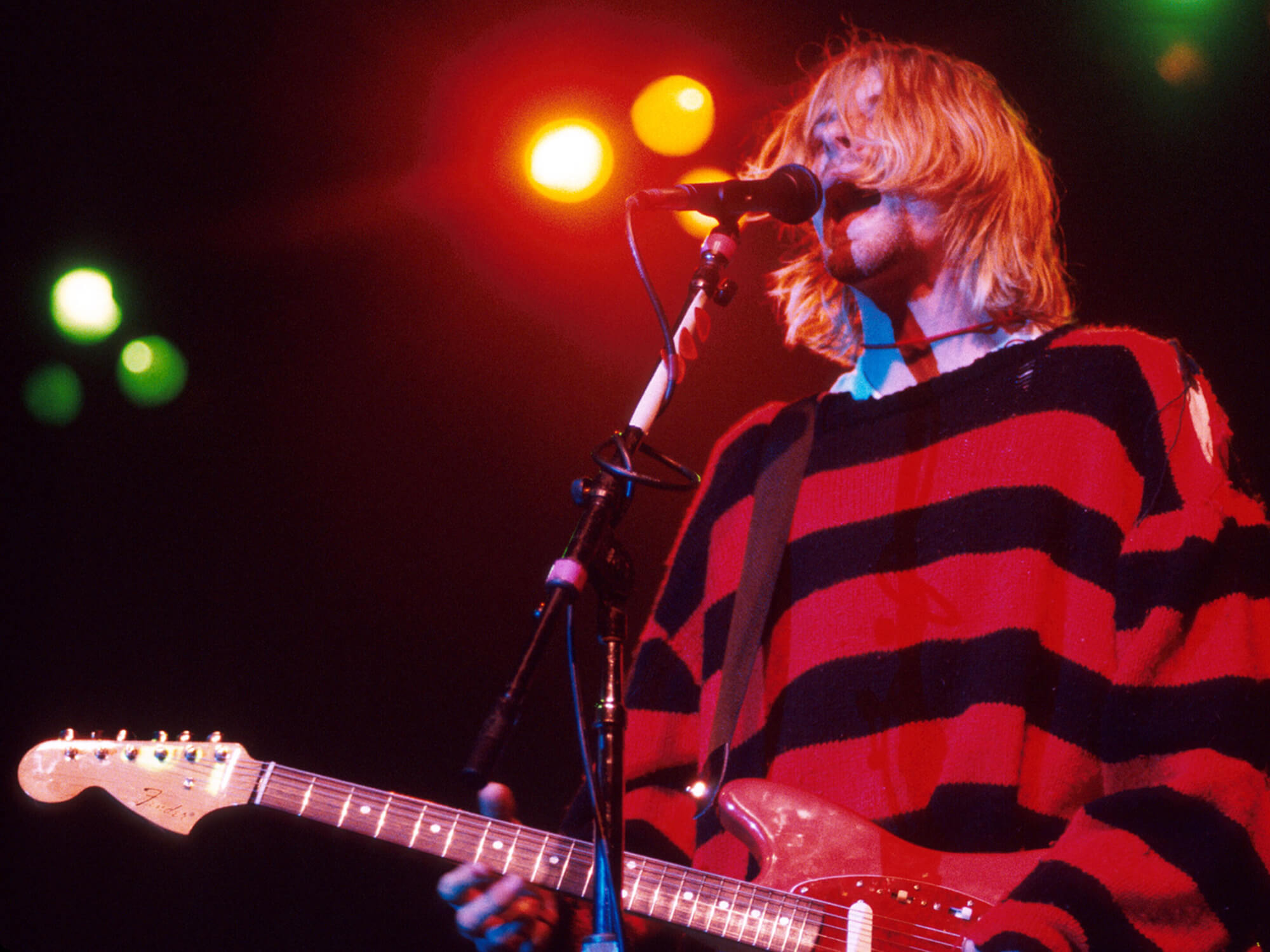
A rare piece of Nirvana history has hit the auction block. Previously unseen footage of the band’s February 1990 gig at Iguanas in Tijuana, Mexico is going under the hammer – and it’s expected to fetch up to $150,000.
- READ MORE: The Guitar Gear Used on Bleach by Nirvana
The video, which runs just over 45 minutes, captures the grunge icons in their early Bleach era. The night also saw legendary frontman Kurt Cobain smashing not one but two guitars: a DIY pink Mustang and a 1970s Gibson SG.
The footage was captured across two Sony Video 8 master cassette tapes, labelled “Original Master Camera-A” and “Camera B”, complete with scrawled tape stickers reading “Nirvana I” and “Nirvana II.” Bonhams, which is handling the sale, expects the lot to fetch between $100,000 and $150,000.
It’s not just the tapes that are included. The package also comes with digital transfers of the footage on two Sony mini DVs, a portable SSD drive loaded with the “complete, digitised raw footage from both cameras, the professionally edited version of the concert, the edited version of the concert with a security watermark, and some stills taken from the video files”, as well as a US Copyright Office Certificate of Registration for the filming and editing of the show.
Collectors will also find some choice extras, including an original Nirvana tour poster for their 15 February show at Raji’s nightclub in Los Angeles – just two nights before Tijuana – plus a Sub Pop first pressing of Bleach on white vinyl, limited to just 1,000 copies.
Thirteen songs made the setlist that night, all delivered with the feral energy that would soon make Nirvana world-famous.
The sale is part of Bonhams’ Unplugged & Unforgettable: Music Auction, which closes Thursday, 24 September, at 12pm PDT.
Learn more at Bonhams.
The post Unseen Nirvana footage from 1990 gig – where Kurt Cobain smashed two guitars – surfaces at auction appeared first on Guitar.com | All Things Guitar.
Emerald Ox FX GLTTR! review: “one of the most out-there ‘effects’ you’ll ever play”

£136, notpedals.com
While there may be a disco-ball on the front of the GLTTR!, have it place you under no illusion. There is little understating how totally unsuitable this unit is for attempting some funky Nile Rogers-style chops. You’d sooner kickstart the next disco revolution by cutting a goose in half with a guitar string.
- READ MORE: Meet NotPedals.com, a marketplace that’s making boutique handmade pedals more accessible than ever
What is the GLTTR!?
First of all, it’s a pedal with an exclamation point in its name – so no, the question in the sub-heading above has not been delivered in a desperate shout, but it would be appropriate if it was. The GLTTR! is one of those things that get listed as “other” or “glitch/weird” – and it earns it. Engaging the pedal for the first time I am met with an overwhelming, incomprehensible wall of sound. As per the manufacturer’s copy, GLTTR! “generates cascading noise that evolves over time,” and “even reacts to your playing when it feels like it.”
Indeed, this is only sort of an effects pedal review – in reality, the GLTTR! is a synth in disguise. It will allow you to mix in your guitar sound, and it even distorts it for you as well, because why not. However, the interaction between your playing and the sounds the GLTTR! produces is arcane – it’s there, but it’s hardly a one-to-one relationship.
While a delay chip is the heart of the GLTTR!’s noise-generation, there are a scant few settings where your signal is repeated back to you in any tangible way. And, for the most part, you can use the GLTTR! totally on its lonesome, without anything plugged in, if you so desire. It’s a pedal that can do the job of a big pile of modular gear, in the specific setting of noisily feeding everything back into itself to create violent cochlea sandpaper – the job of the musician, in the case of things like GLTTR!, is less about playing the gear and more about shaping it and directing the flow of the output.
 Image: Press
Image: Press
This is because regardless of what’s going on at the input stage, GLTTR!’s output resembles a Merzbow album – replete with digital, harsh pulses and totally abstract howls, as if the little delay chip in here was granted the ability to feel pain. For genres where consonance, rhythm and harmony have been abandoned, though, the GLTTR!’s controls are extremely inviting.
The texture of the noise is thick, and the various controls poke and prod the resulting oscillations in various directions– the manual describes the “!!!” control as the “most important”, however it’s how it works in tandem with the various switches – specifically the “???” switch – to give you some really varying outputs, going from low growls with occasionally digital screeches at random intervals to high, piercing screams with blasts of white noise.
The on-board LFO, when set right, will also let you dance between some varying extremes, pushing and pulling the texture of the noise in great crashing waves. At some settings it even tortures the delay chip so drastically that it simply gives up and turns off, leading to stark, sudden silences amidst the total chaos. In these moments, before the howls return, you contemplate life before the GLTTR!, life after the GLTTR!, and the gulf between these two things.
Who is the GLTTR! for?
I would heartily recommend the GLTTR! To anyone who genuinely likes a bit of noise music in their life – you could otherwise achieve a similarly three-dimensional and variable noise sound with a more in-depth modular setup, but the GLTTR! Lets you dip your toes into that world in a familiar stompbox format.
With that said, anyone who is expecting a guitar effect that’s, well, an actual guitar effect, may feel like this is unusable in most circumstances. If you turned this pedal on during a “normal” guitar set, the sound engineer will probably start trying to figure out what just exploded. That’s not to say it doesn’t have its place in a ‘band’ setting – for some alarming noises between songs, I can see the GLTTR! doing a great job too. Just keep in mind that for best results, you may need to crouch down and do some knob-twiddling on stage.
The post Emerald Ox FX GLTTR! review: “one of the most out-there ‘effects’ you’ll ever play” appeared first on Guitar.com | All Things Guitar.
Trey Hensley Plays His New Taylor Gold Label 517e Grand Pacific
PRS Guitars Releases a Reclaimed Wood Limited Edition of the S2 Special Semi-Hollow
PRS Guitars today announced the launch of the S2 Special Semi-Hollow Reclaimed Limited Edition. This limited edition showcases reclaimed and salvaged woods on one of the company’s most versatile models: the S2 Special Semi-Hollow. With each top boasting its own character and left as natural as possible, every instrument is rendered unique. Only 700 pieces will be made in 2025.
The unique reclaimed material was discovered by longtime PRS wood buyer Michael Reid.
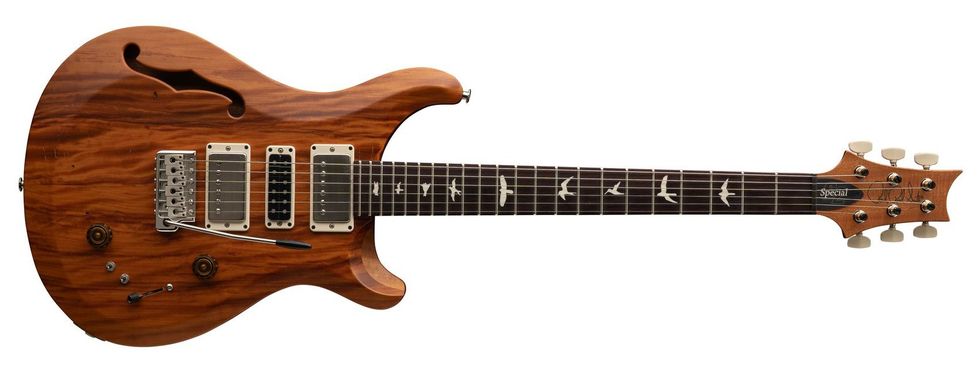
“Wood is a crucial element to our guitar making heritage. Michael Reid, our senior wood buyer, has been my curly maple wood provider and buyer since 1980 - before PRS was officially PRS - and we still work together as partners today. The deep relationships Michael has formed worldwide with our wood suppliers are remarkable. Guitars like this are a great way to highlight some of the interesting, personal stories from his travels and musical wood understanding,” said Paul Reed Smith.
The woods featured on this model include a Peroba Rosa top, Cuban mahogany neck, and Guaribu fretboard. Peroba Rosa, typically used as siding in Brazil, was selected for the top wood. The density of this 100-150-year-old wood combined with the semi-hollow body construction gives the S2 Special Semi-Hollow Reclaimed Limited Edition a unique sound that is punchy but also warm and full. The Cuban mahogany used for the necks was purchased from Puerto Rico, and some of this wood was salvaged from trees blown down by Hurricane Maria in 2017. Finally, the Guaribu Preto fretboards are sourced from Brazil, where this wood was historically used as support beams for houses. These guitars are left Natural in color and finished in satin nitro. Any nail holes, wear, or discoloration have been left in the top wood to showcase its history.
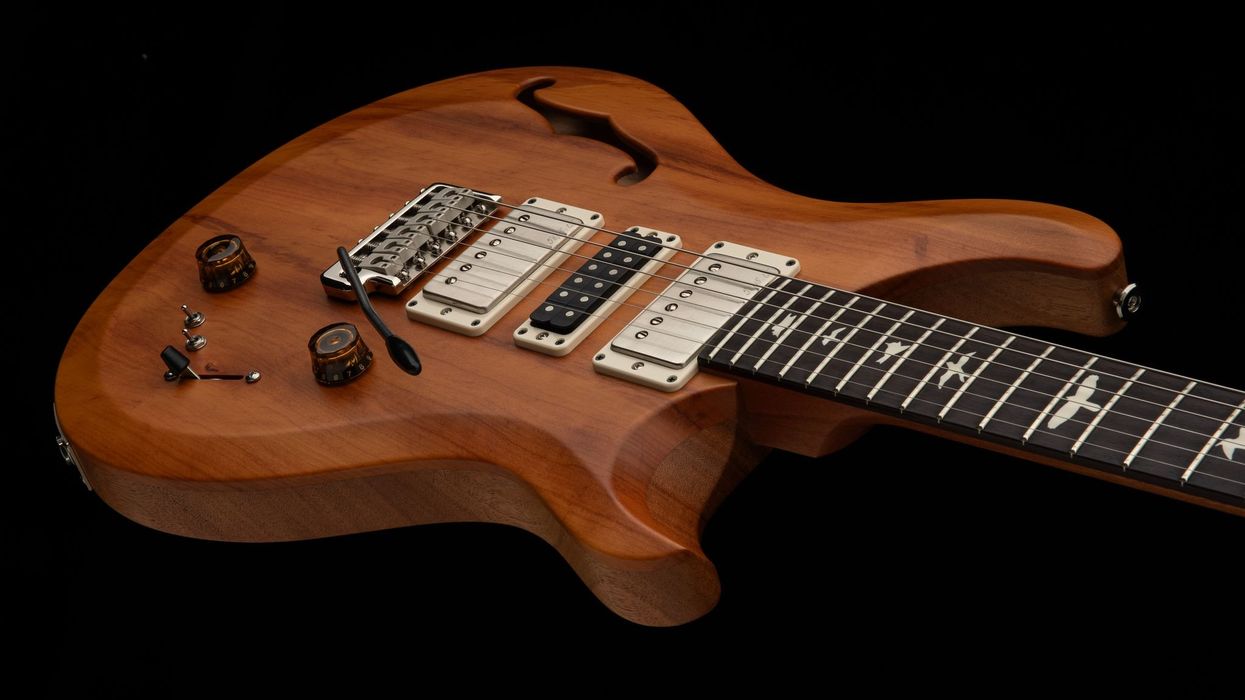
“It is impossible to fool a good guitar player. Everyone who has a guitar made from these woods sees them as a legitimate tool for serious players, not as a gimmick,” said Michael Reid, PRS Guitars Senior Wood Buyer. To hear more from Michael Reid on these woods and how these guitars came to be, visit the PRS Guitars Blog by clicking here.
Beyond their unique wood appointments, these instruments maintain many of the S2 Special Semi-Hollow’s standard specifications, including a 22-fret, 25” scale length Pattern Regular neck and hum/Narrowfield/hum pickup configuration. A 5-way blade switch and two mini-toggles allow players to tap the humbuckers, creating twelve distinct pickup combinations.
PRS Guitars continues its schedule of launching new products each month in 2025. Stay tuned to see new gear and 40th Anniversary limited-edition guitars throughout the year. For all of the latest news, click www.prsguitars.com/40 and follow @prsguitars on Instagram, Tik Tok, Facebook, X, and YouTube.
EMG’s New E-Series: Jazz Snap Meets Humbucker Punch!
PG contributor Steve Cook takes a look at EMG’s new E-Series bass pickups—a set of slim, soapbar, active pickups that feature wide-aperture coils and ceramic magnets. The E-Series offers big lows, articulate highs, and noiseless performance, the calling card of EMG’s active pickup designs. With drop-in replacement and full compatibility with EMG accessories, the E-Series presents a serious option for modern bassists.
Shop For Your E-Series: https://www.emgpickups.com/bass/e-ser...


